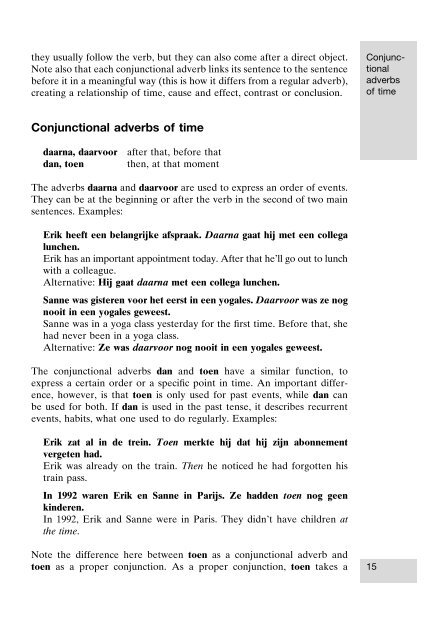er - Home
er - Home
er - Home
You also want an ePaper? Increase the reach of your titles
YUMPU automatically turns print PDFs into web optimized ePapers that Google loves.
they usually follow the v<strong>er</strong>b, but they can also come aft<strong>er</strong> a direct object.<br />
Note also that each conjunctional adv<strong>er</strong>b links its sentence to the sentence<br />
before it in a meaningful way (this is how it diff<strong>er</strong>s from a regular adv<strong>er</strong>b),<br />
creating a relationship of time, cause and effect, contrast or conclusion.<br />
Conjunctional adv<strong>er</strong>bs of time<br />
daarna, daarvoor aft<strong>er</strong> that, before that<br />
dan, toen then, at that moment<br />
The adv<strong>er</strong>bs daarna and daarvoor are used to express an ord<strong>er</strong> of events.<br />
They can be at the beginning or aft<strong>er</strong> the v<strong>er</strong>b in the second of two main<br />
sentences. Examples:<br />
Erik heeft een belangrijke afspraak. Daarna gaat hij met een collega<br />
lunchen.<br />
Erik has an important appointment today. Aft<strong>er</strong> that he’ll go out to lunch<br />
with a colleague.<br />
Alt<strong>er</strong>native: Hij gaat daarna met een collega lunchen.<br />
Sanne was gist<strong>er</strong>en voor het e<strong>er</strong>st in een yogales. Daarvoor was ze nog<br />
nooit in een yogales geweest.<br />
Sanne was in a yoga class yest<strong>er</strong>day for the first time. Before that, she<br />
had nev<strong>er</strong> been in a yoga class.<br />
Alt<strong>er</strong>native: Ze was daarvoor nog nooit in een yogales geweest.<br />
The conjunctional adv<strong>er</strong>bs dan and toen have a similar function, to<br />
express a c<strong>er</strong>tain ord<strong>er</strong> or a specific point in time. An important diff<strong>er</strong>ence,<br />
howev<strong>er</strong>, is that toen is only used for past events, while dan can<br />
be used for both. If dan is used in the past tense, it describes recurrent<br />
events, habits, what one used to do regularly. Examples:<br />
Erik zat al in de trein. Toen m<strong>er</strong>kte hij dat hij zijn abonnement<br />
v<strong>er</strong>geten had.<br />
Erik was already on the train. Then he noticed he had forgotten his<br />
train pass.<br />
In 1992 waren Erik en Sanne in Parijs. Ze hadden toen nog geen<br />
kind<strong>er</strong>en.<br />
In 1992, Erik and Sanne w<strong>er</strong>e in Paris. They didn’t have children at<br />
the time.<br />
Note the diff<strong>er</strong>ence h<strong>er</strong>e between toen as a conjunctional adv<strong>er</strong>b and<br />
toen as a prop<strong>er</strong> conjunction. As a prop<strong>er</strong> conjunction, toen takes a<br />
Conjunctional<br />
adv<strong>er</strong>bs<br />
of time<br />
15


